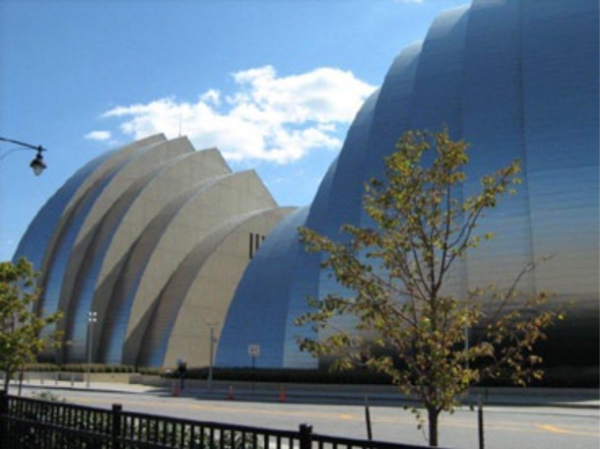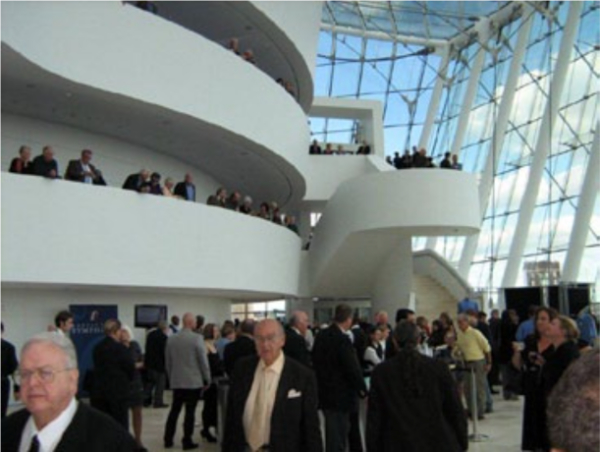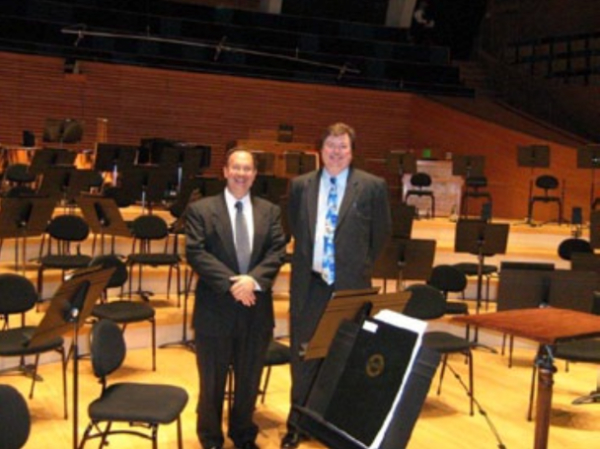When I joined the Kansas City Symphony (KCS) in 1995, my father, an accomplished amateur musician in his own right, often inquired whether “ev’rything’s up to date in Kansas City,” a reference to the musical, Oklahoma! Little did any of us know in 1995 what would lie ahead for the fourteen-year-old orchestra and our community.
The KCS was borne out of the ashes of the former Kansas City Philharmonic, an important major orchestra for many decades. One of the guiding principles of the new KCS was to balance budgets. Deficits of any amount were not to be allowed and there would be no lines of credit. Through the generosity of the local banker and philanthropist R. Crosby Kemper Jr., a new endowment emerged and quickly grew to ten million dollars. Initial KCS annual budgets were approximately one million dollars. This meant that a KCS musician earned just ten thousand dollars annually those early years, with few benefits—a far cry from the nearly thirty thousand dollars under the Kansas City Philharmonic.
The KCS succeeded and grew while maintaining balanced budgets. However, another guiding principle early on was that the “union” would not be recognized, at least not right away. Maybe later, the musicians were told but not at the beginning. Months turned into years, and, all the while, KCS musicians were denied the benefits of collective bargaining, including compensation and working conditions comparable to our industry peers. Yet, rather admirably, the musicians remained loyal members of the American Federation of Musicians and even permitted work dues to be withheld from their paychecks.
In 1995 a remarkable local philanthropic leader came forward to lead the KCS. Mrs. Barnett C. (Shirley) Helzberg Jr., a champion of the arts and education in Kansas City, became the KCS board chair. Shirley quickly created a culture of cooperative governance and musician empowerment while steadfastly adhering to the guiding principle of balanced budgets. Mrs. Helzberg continues to lead by example with extraordinary donations, sponsorships, and gifts of tremendous magnitude to support the KCS and our musicians. The board also hired a new executive director, Roland Valliere, and a new personnel manager, Dave Clark. Both contributed immensely to the Symphony’s growth over the next several years, as did the many staff, board members, music directors, and musicians who spent valuable years with the KCS family.
September 16–17, 2011 will be remembered as perhaps the most important dates in the history of the KCS. On those days, musicians, staff, board members, and classic music lovers alike enjoyed the grand opening gala of the Kauffman Center for the Performing Arts, now the home of the KCS.

The Kauffman Center for the Performing Arts in Kansas City.
Photo credit: Bruce Ridge
The larger performance hall is the Kauffman Theater, named for Ms. Julia Irene Kauffman’s mother, Mrs. Muriel Kauffman. The Kauffman Theater is the home of the Kansas City Ballet and the Lyric Opera of Kansas City. The KCS is the pit orchestra for both resident companies.
The second performance hall is Helzberg Hall, named for Mr. and Mrs. Barnett C. Helzberg Jr. The KCS is the resident organization of Helzberg Hall. Many other performing arts groups also perform regularly at the KCPA.
Both Ms. Kauffman and Mrs. Helzberg continue to emphasize that the Kauffman Center was built for the masses—for arts lovers throughout Kansas City and for visitors to our city from around the world. For example, the KCPA graciously opened its doors one rainy Sunday afternoon and invited everyone to tour the Center and enjoy performances in both halls, all free of charge. Ms. Kauffman stood at the entrance when the doors opened at noon and could still be seen shaking hands and greeting everyone in line at closing time five hours later. Around twenty thousand people were initially expected. Even with the rain, estimates are that more than fifty thousand actually made their way to the KCPA.
Mrs. Helzberg addressed the audiences in Helzberg Hall prior to each performance during the KCS’s classical series opening weekend. Shirley asked the audience members to imagine that they were coming downtown to hear the Symphony in their own hall, with their surname on the hall itself. If they were the Smiths, then they were coming to Smith Hall to hear the Symphony. She and Barnett truly wish for everyone to feel that Helzberg Hall is their own.

The impressive glass-encased lobby of the Kauffman Center for the Performing Arts.
Photo credit: Bruce Ridge
On Saturday evening, Susan Martin, our brilliant attorney/negotiator and close friend, brought her family to enjoy the opening. Sunday afternoon we were honored to have ICSOM Chairperson Bruce Ridge join us for the performance. Susan and Bruce met with KCS musicians prior to both performances during informal meet-and-greet sessions held backstage. Many musicians came to my home Sunday evening to visit with Bruce and enjoyed homemade KC BBQ pulled pork. Bruce stayed over Sunday night and addressed the orchestra during an opera rehearsal on Monday.
If Ms. Kauffman, Mrs. Helzberg, and other philanthropic leaders had not been steadfast in their pursuit of the dream of a world-class performing arts center in Kansas City, the KCPA might well never have been built. While the dream emerged many years ago and was widely discussed in the late 1990s, the economic and political challenges of the early 2000s may have deterred less committed and passionate leaders. During a decade that included the horrific events of September 11, a global financial meltdown and subsequent recession, and the distressing bankruptcies of several orchestras, Kansas City leaders found ways to weather the storm in order to build the performing arts center of their dreams.
There are many other people who deserve recognition for their enormous contributions toward the creation of the KCPA and the KCS’s position as a resident organization. American music directors are in unique positions. When successful, they capture the imagination and attention of a city. Gustamo Dudamel in Los Angeles and Michael Tilson Thomas in San Francisco are two west-coast examples, and Kansas City’s version is Michael Stern. Michael is virtually everywhere visiting with donors and those who may not yet know they are about to become donors. He does this while meticulously caring for every artistic detail. Executive directors can make or break the orchestras they manage. I know of no one who works harder or is more dedicated to his orchestra and the art form than our executive director, Frank Byrne. In addition to Mrs. Helzberg, we have an incredible board of trustees at the KCS. Remarkably, four members of the executive committee have been together since 1995.
Anyone familiar with orchestras appreciates how hard staff members work. Yet, they are almost always quite underpaid. As a result, turnover is typically higher than in the for-profit world. It is safe to say, however, that the KCS would not be where it is physically, financially, or artistically without the many staff members who worked for the KCS.
Last, and certainly not least, are the musicians. The ongoing success of the KCS would not be possible without the tremendous contributions of the current and the former members of the KCS and the Kansas City Philharmonic. Every musician that was a KCS/ Philharmonic member these past many years deserves to call the KCPA home. Through their lifelong dedication and commitment to incredible artistry and collective solidarity, the KCS has blossomed into a major orchestra that Kansas City may be proud of.

Onstage for the opening of the Kauffman Center for the Performing Arts are ICSOM President Brian Rood (left) and ICSOM Chairperson Bruce Ridge.
Success in Kansas City is due to many factors. Clearly, the major factor was a convergence of the right people at the right time. Over the past 15 years board members, staff personnel, volunteers, musicians, and music directors, as well as civic and arts leaders, worked together toward the goals of improving the KCS financially and artistically and to prepare to move into the KCPA. It is important to note that differences have surfaced from time to time among the different constituencies. We resolved those differences by keeping our eye on the prize.
In early 2006, amid the economic uncertainties of the last decade, the KCPA board issued a public challenge calling for $40 million to be immediately raised in order to assure that ground would be broken. The Musicians’ Association of the Kansas City Symphony unanimously supported the challenge request. While everyone contributed a nominal amount, many gave more, and over $17,000 was raised. We knew this was a drop in the bucket of the KCPA’s $413 million total cost, but we wanted everyone involved to understand that we were on board, too.
We were pleasantly surprised to learn that these contributions entitled us to name five seats in Helzberg Hall. We named two for the Kansas City Musicians’Association, Local 34-627, AFM, one for the emeriti KCS musicians, and one each for two of our fallen colleagues. Their inscriptions are: Veronica Freeman, Cellist, 1973-2004, An English Rose Who Blossomed Here amid a Hundred Musical Friends; Steve Peters, 1954-2005, Bassist, Devoted Son & Dad, Looked for the Best in Others and Gave His Best
As I write this column, my father and his dear wife are set to travel to Kansas City to experience the Kauffman Center for the Performing Arts for the first time. I look forward to showing him that, indeed, “Ev’rything’s up to date in Kansas City.” Yet no one thinks “They’ve gone about as fur as they c’n go.” We recognize that this tremendous opportunity is not the end of the road but just the beginning.





